2011 TOYOTA YARIS SEDAN service
[x] Cancel search: servicePage 253 of 406
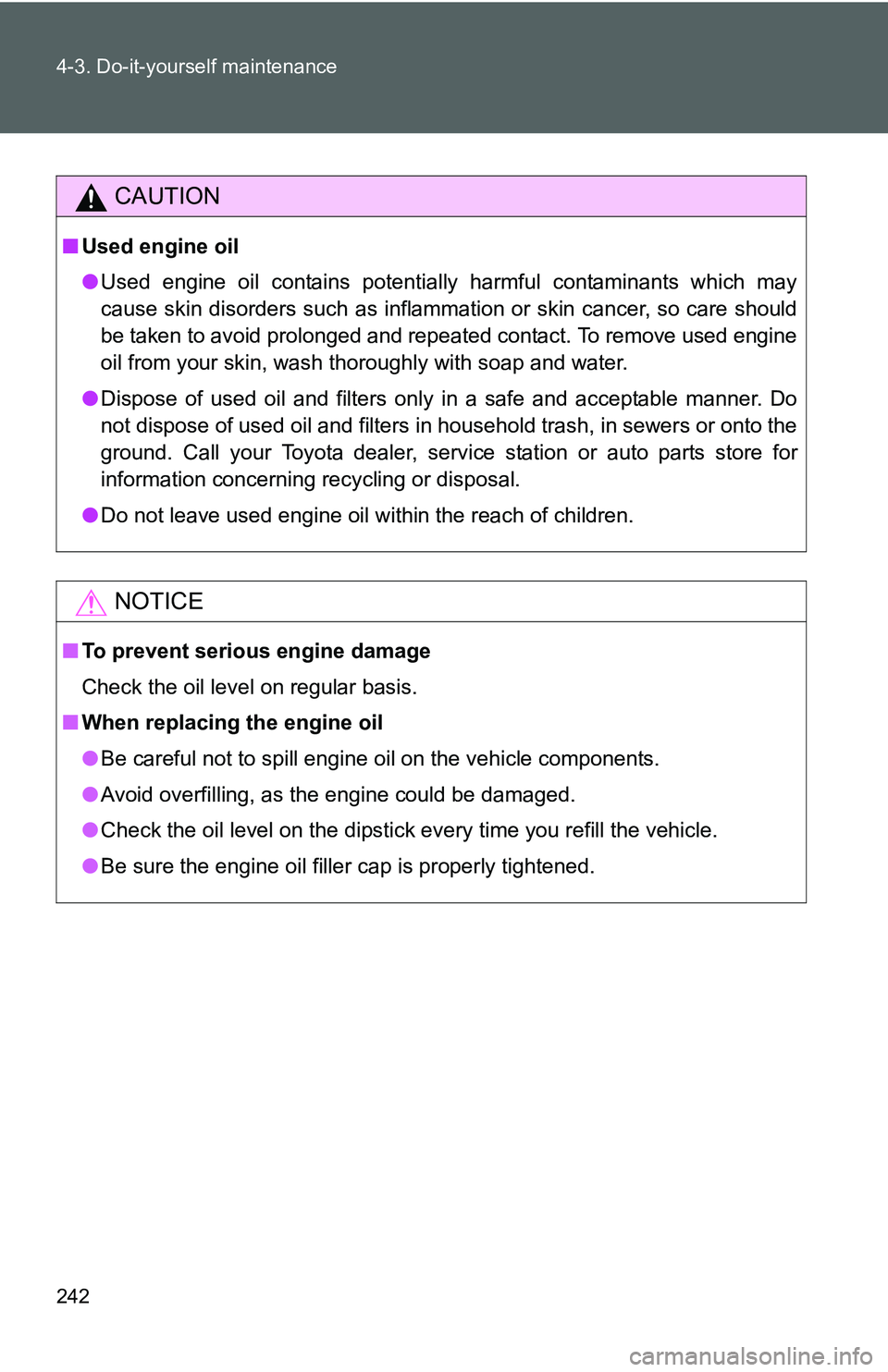
242 4-3. Do-it-yourself maintenance
CAUTION
■Used engine oil
●Used engine oil contains potentially harmful contaminants which may
cause skin disorders such as inflammation or skin cancer, so care should
be taken to avoid prolonged and repeated contact. To remove used engine
oil from your skin, wash thoroughly with soap and water.
● Dispose of used oil and filters only in a safe and acceptable manner. Do
not dispose of used oil and filters in household trash, in sewers or onto the
ground. Call your Toyota dealer, service station or auto parts store for
information concerning recycling or disposal.
● Do not leave used engine oil within the reach of children.
NOTICE
■To prevent serious engine damage
Check the oil level on regular basis.
■ When replacing the engine oil
●Be careful not to spill engine oil on the vehicle components.
● Avoid overfilling, as the engine could be damaged.
● Check the oil level on the dipstick every time you refill the vehicle.
● Be sure the engine oil filler cap is properly tightened.
Page 272 of 406

261
4-3. Do-it-yourself maintenance
4
Maintenance and care
■When replacing wheels (vehicles with a tire pressure warning sys-
tem)
The wheels of your Toyota, except for the compact spare tire, are
equipped with tire pressure warning valves and transmitters that allow
the tire pressure warning system to provide advanced warning in the
event of a loss in tire inflation pressure. Whenever wheels are replaced,
the tire pressure warning valves a
nd transmitters must be installed.
( → P. 251)
CAUTION
■When replacing wheels
●Do not use wheels that are a different size from those recommended in
the Owner’s Manual, as this may re sult in loss of handling control.
●Never use an inner tube in a leaking wheel which is designed for a
tubeless tire. Doing so may result in an accident, causing death or seri-
ous injury.
NOTICE
■Replacing tire pressure warning valves and transmitters (vehicles
with a tire pressure warning system)
●Because tire repair or replacement may affect the tire pressure warn-
ing valves and transmitters, make su re to have tires serviced by your
Toyota dealer or other qualified service shop. In addition, make sure to
purchase your tire pressure warning valves and transmitters at your
Toyota dealer.
●Ensure that only genuine Toyota wheels are used on your vehicle.
Tire pressure warning valves and transmitters may not work properly
with non-genuine wheels.
Page 301 of 406
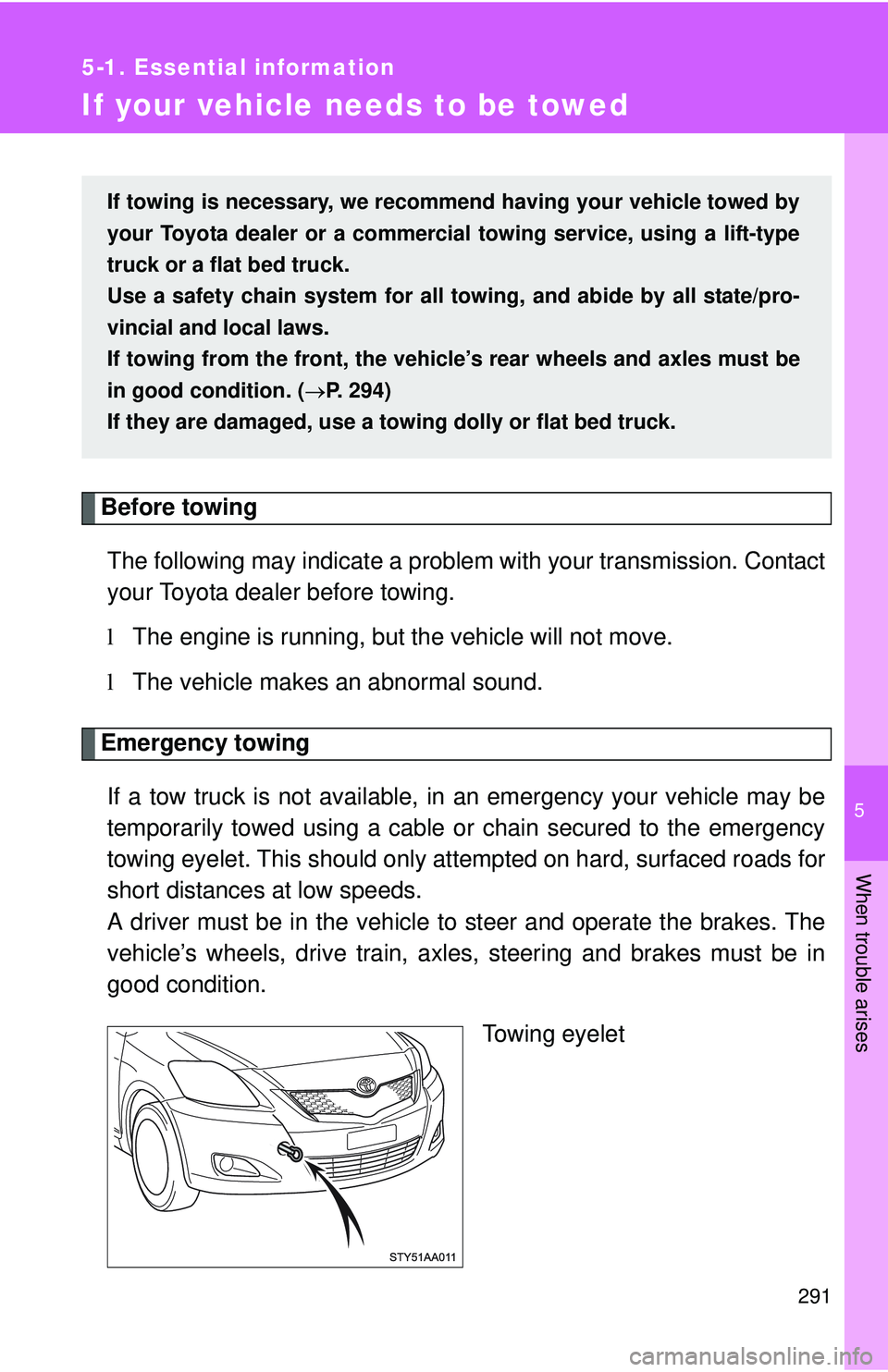
5
When trouble arises
291
5-1. Essential information
If your vehicle needs to be towed
Before towingThe following may indicate a problem with your transmission. Contact
your Toyota dealer before towing.
l The engine is running, but the vehicle will not move.
l The vehicle makes an abnormal sound.
Emergency towing
If a tow truck is not available, in an emergency your vehicle may be
temporarily towed using a cable or chain secured to the emergency
towing eyelet. This should only attempted on hard, surfaced roads for
short distances at low speeds.
A driver must be in the vehicle to steer and operate the brakes. The
vehicle’s wheels, drive train, axles, steering and brakes must be in
good condition.
Towing eyelet
If towing is necessary, we recommend having your vehicle towed by
your Toyota dealer or a commerci al towing service, using a lift-type
truck or a flat bed truck.
Use a safety chain system for all to wing, and abide by all state/pro-
vincial and local laws.
If towing from the front, the vehic le’s rear wheels and axles must be
in good condition. (→ P. 294)
If they are damaged, use a towing dolly or flat bed truck.
Page 359 of 406
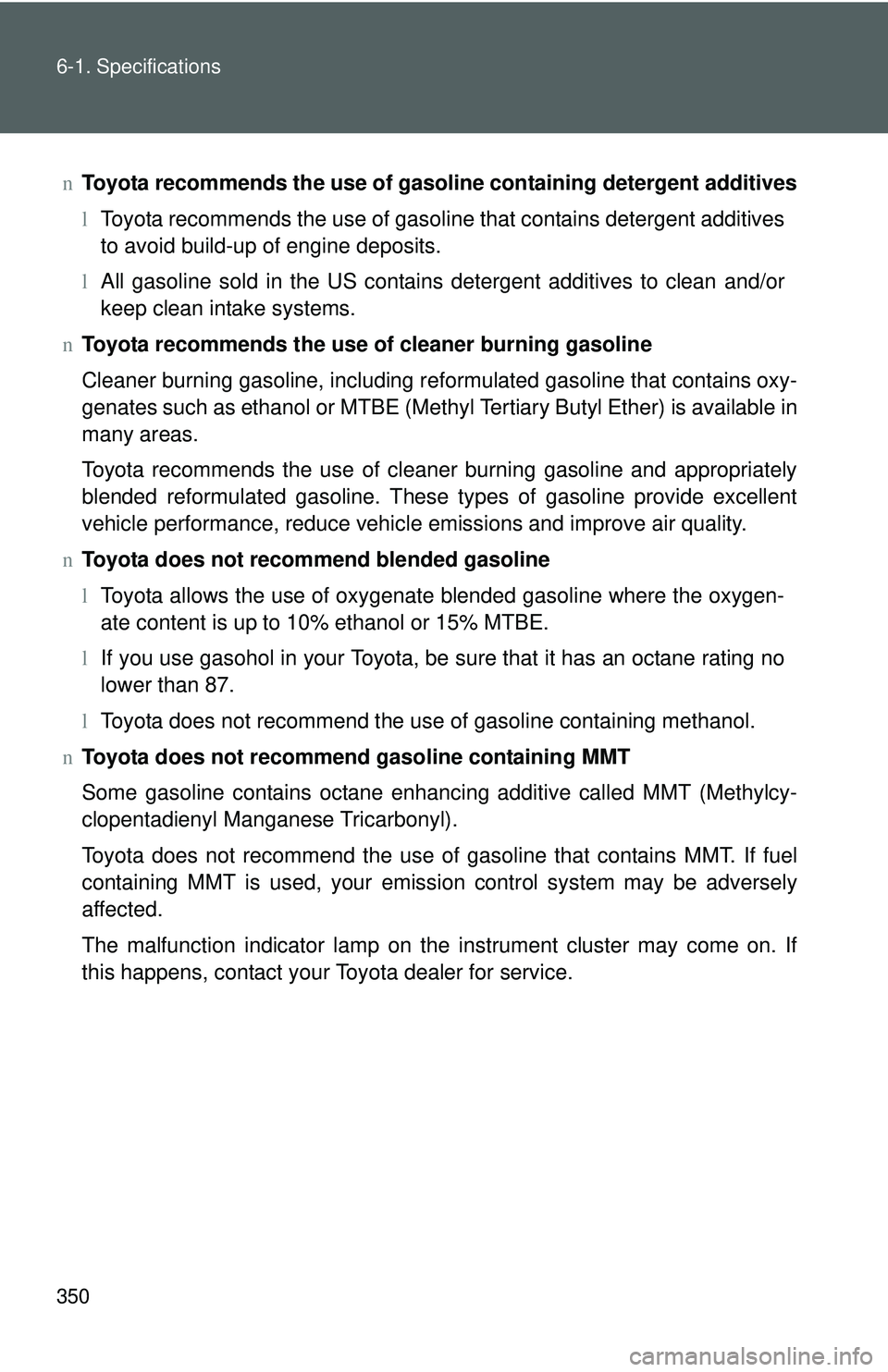
350 6-1. Specifications
nToyota recommends the use of gaso line containing detergent additives
l Toyota recommends the use of gasoline that contains detergent additives
to avoid build-up of engine deposits.
l All gasoline sold in the US contains detergent additives to clean and/or
keep clean intake systems.
n Toyota recommends the use of cleaner burning gasoline
Cleaner burning gasoline, including reformulated gasoline that contains oxy-
genates such as ethanol or MTBE (Methyl Tertiary Butyl Ether) is available in
many areas.
Toyota recommends the use of cleaner burning gasoline and appropriately
blended reformulated gasoline. These types of gasoline provide excellent
vehicle performance, reduce vehicle emissions and improve air quality.
n Toyota does not recomm end blended gasoline
l Toyota allows the use of oxygenate blended gasoline where the oxygen-
ate content is up to 10% ethanol or 15% MTBE.
l If you use gasohol in your Toyota, be sure that it has an octane rating no
lower than 87.
l Toyota does not recommend the use of gasoline containing methanol.
n Toyota does not recommen d gasoline containing MMT
Some gasoline contains octane enhancing additive called MMT (Methylcy-
clopentadienyl Manganese Tricarbonyl).
Toyota does not recommend the use of gasoline that contains MMT. If fuel
containing MMT is used, your emission control system may be adversely
affected.
The malfunction indicator lamp on the instrument cluster may come on. If
this happens, contact your Toyota dealer for service.
Page 367 of 406
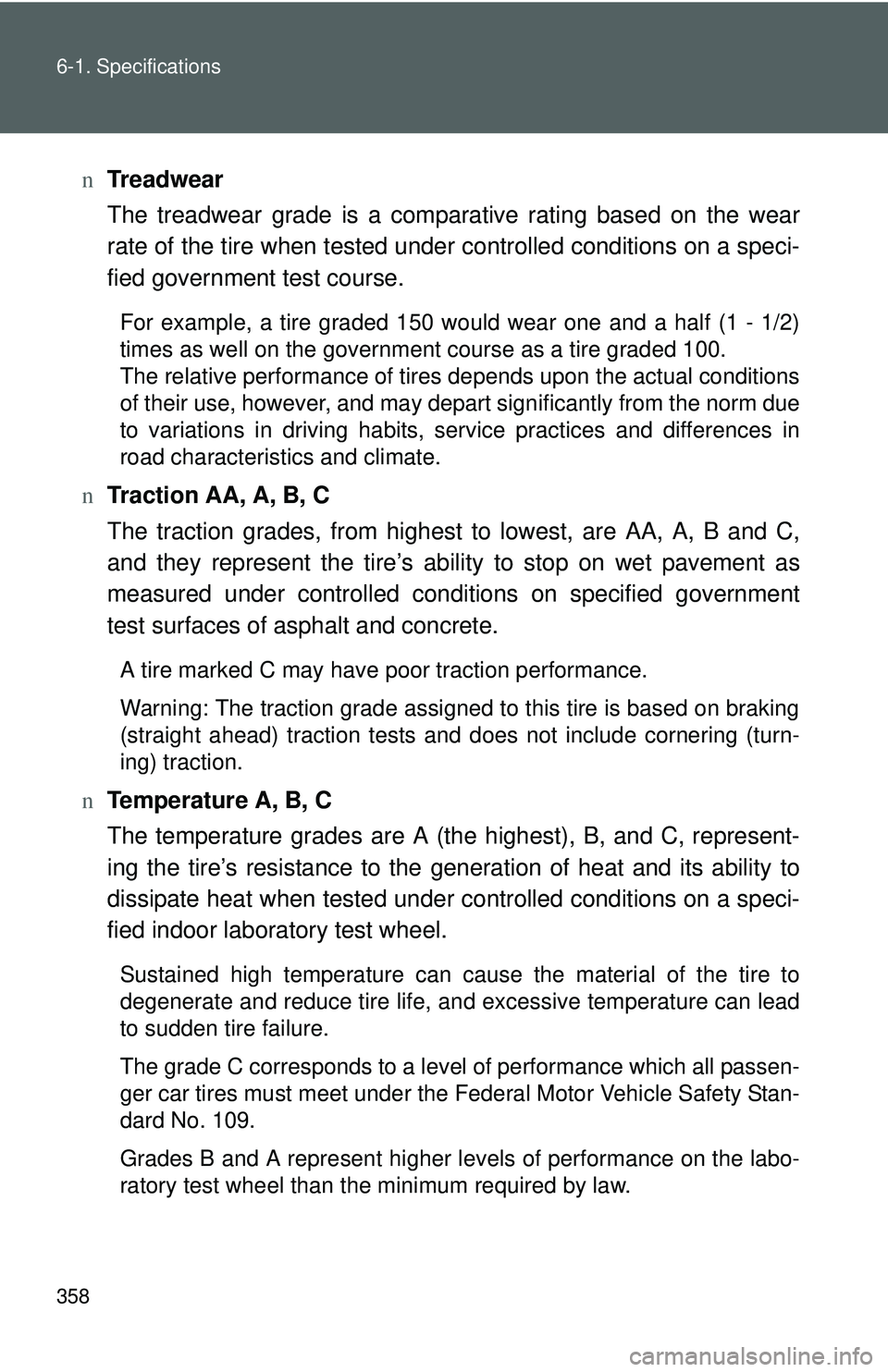
358 6-1. Specifications
nTreadwear
The treadwear grade is a comparative rating based on the wear
rate of the tire when tested under controlled conditions on a speci-
fied government test course.
For example, a tire graded 150 would wear one and a half (1 - 1/2)
times as well on the government course as a tire graded 100.
The relative performance of tires depends upon the actual conditions
of their use, however, and may depart significantly from the norm due
to variations in driving habits, service practices and differences in
road characteristics and climate.
n Traction AA, A, B, C
The traction grades, from highest to lowest, are AA, A, B and C,
and they represent the tire’s ab ility to stop on wet pavement as
measured under controlled cond itions on specified government
test surfaces of asphalt and concrete.
A tire marked C may have poor traction performance.
Warning: The traction grade assigned to this tire is based on braking
(straight ahead) traction tests and does not include cornering (turn-
ing) traction.
n Temperature A, B, C
The temperature grades are A (the highest), B, and C, represent-
ing the tire’s resistance to the generation of heat and its ability to
dissipate heat when tested under controlled conditions on a speci-
fied indoor laboratory test wheel.
Sustained high temperature can cause the material of the tire to
degenerate and reduce tire life, and excessive temperature can lead
to sudden tire failure.
The grade C corresponds to a level of performance which all passen-
ger car tires must meet under the Federal Motor Vehicle Safety Stan-
dard No. 109.
Grades B and A represent higher levels of performance on the labo-
ratory test wheel than the minimum required by law.
Page 396 of 406
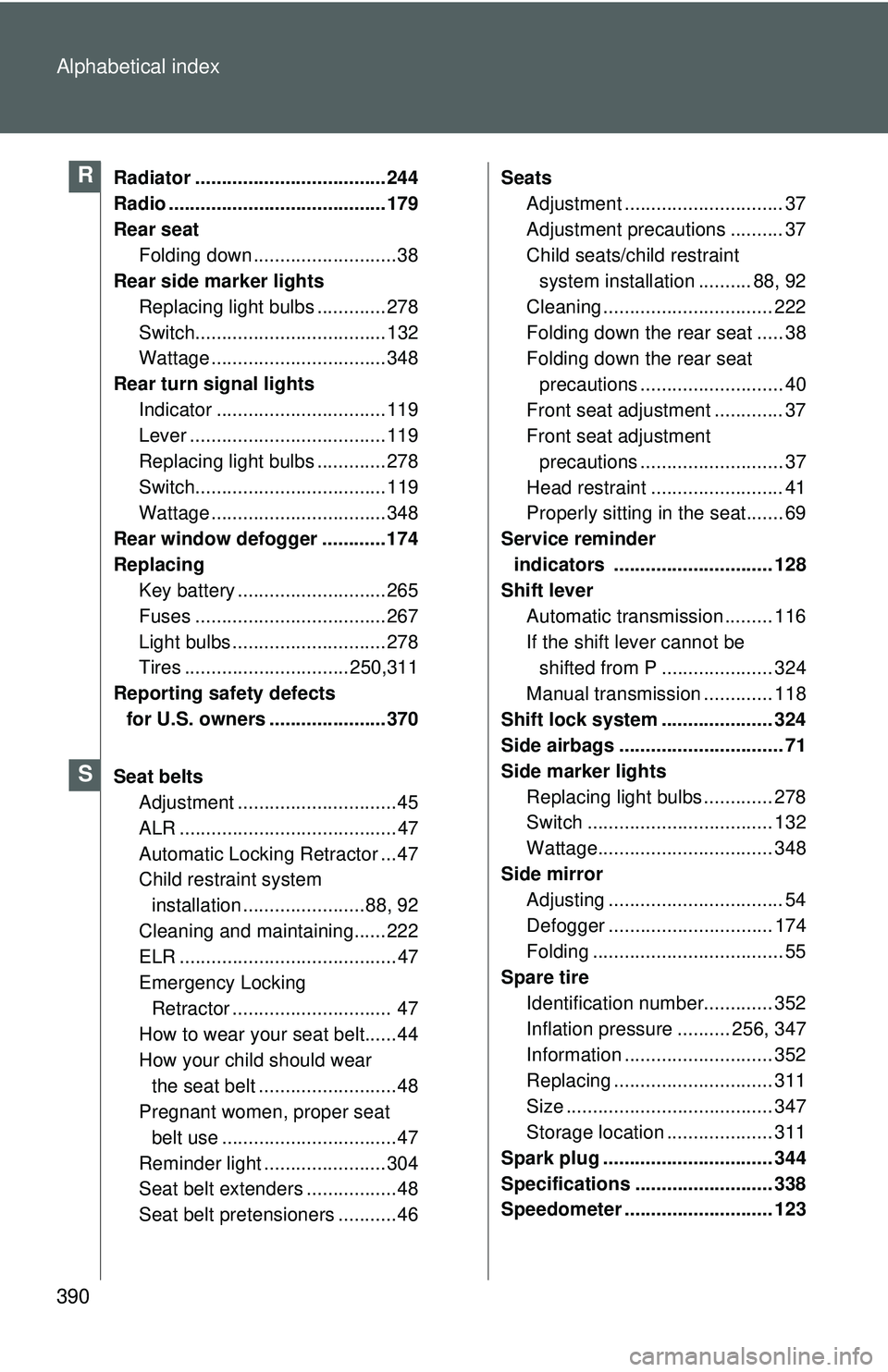
390 Alphabetical index
Radiator .................................... 244
Radio ......................................... 179
Rear seatFolding down ...........................38
Rear side marker lights
Replacing light bulbs ............. 278
Switch.................................... 132
Wattage ................................. 348
Rear turn signal lights Indicator ................................ 119
Lever ..................................... 119
Replacing light bulbs ............. 278
Switch.................................... 119
Wattage ................................. 348
Rear window defogger ............ 174
Replacing Key battery ............................ 265
Fuses .................................... 267
Light bulbs ............................. 278
Tires ...............................250,311
Reporting safety defects for U.S. owners ...................... 370
Seat belts Adjustment ..............................45
ALR .........................................47
Automatic Locking Retractor ...47
Child restraint system
installation .......................88, 92
Cleaning and maintaining...... 222
ELR .........................................47
Emergency Locking Retractor .............................. 47
How to wear your seat belt......44
How your child should wear
the seat belt ..........................48
Pregnant women, proper seat
belt use .................................47
Reminder light ....................... 304
Seat belt extenders .................48
Seat belt pretensioners ...........46 Seats
Adjustment .............................. 37
Adjustment precautions .......... 37
Child seats/child restraint system installation .......... 88, 92
Cleaning ................................ 222
Folding down the rear seat ..... 38
Folding down the rear seat precautions ........................... 40
Front seat adjustment ............. 37
Front seat adjustment precautions ........................... 37
Head restraint ......................... 41
Properly sitting in the seat....... 69
Service reminder indicators .............................. 128
Shift lever
Automatic transmission ......... 116
If the shift lever cannot be shifted from P ..................... 324
Manual transmission ............. 118
Shift lock system ..................... 324
Side airbags ............................... 71
Side marker lights Replacing light bulbs ............. 278
Switch ................................... 132
Wattage................................. 348
Side mirror Adjusting ................................. 54
Defogger ............................... 174
Folding .................................... 55
Spare tire
Identification number............. 352
Inflation pressure .......... 256, 347
Information ............................ 352
Replacing .............................. 311
Size ....................................... 347
Storage location .................... 311
Spark plug ................................ 344
Specifications .......................... 338
Speedometer ............................ 123R
S
Page 405 of 406
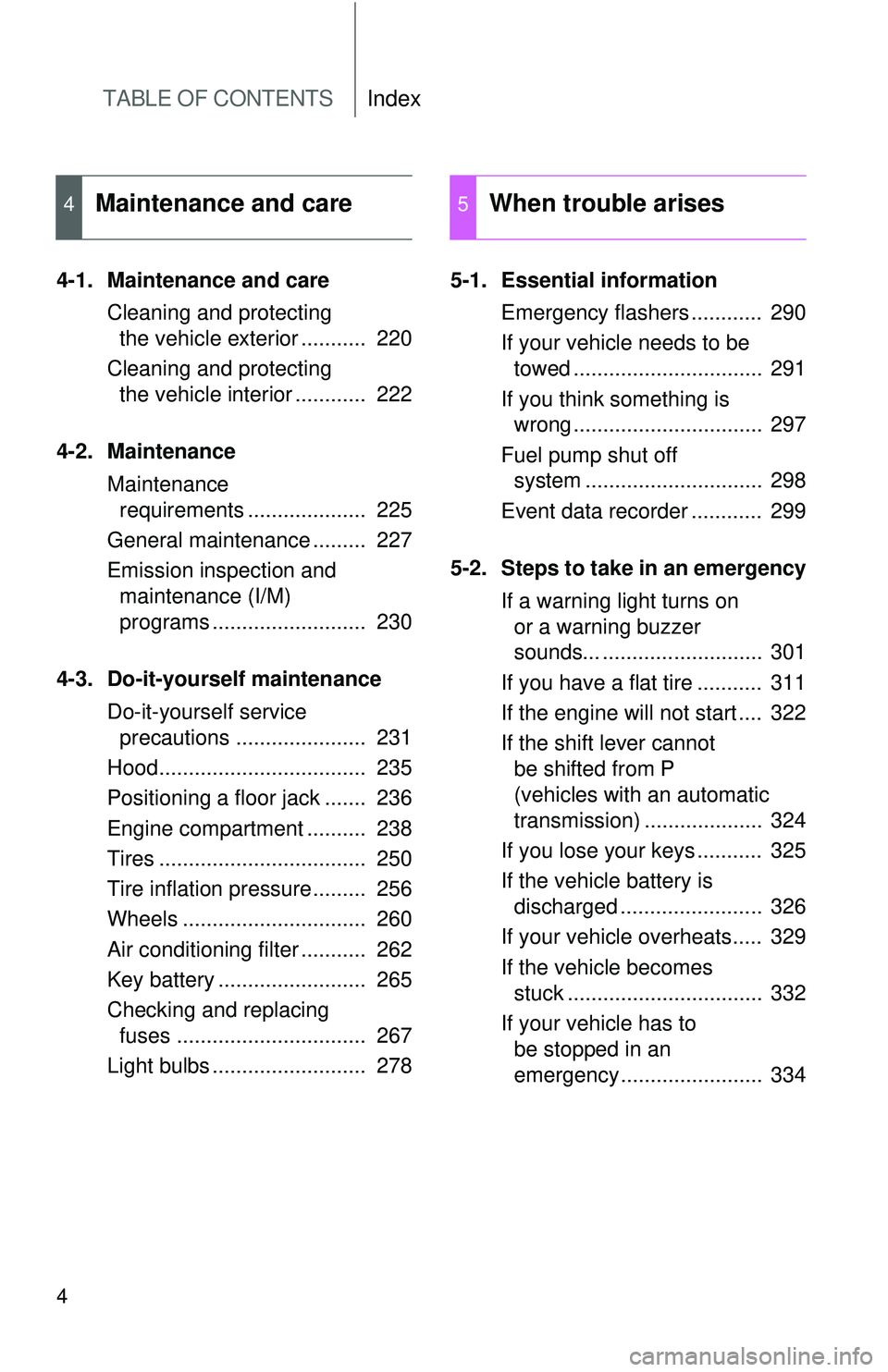
TABLE OF CONTENTSIndex
4
4-1. Maintenance and careCleaning and protectingthe vehicle exterior ........... 220
Cleaning and protecting the vehicle interior ............ 222
4-2. Maintenance Maintenancerequirements .................... 225
General maintenance ......... 227
Emission inspection and maintenance (I/M)
programs .......................... 230
4-3. Do-it-yourself maintenance Do-it-yourself serviceprecautions ...................... 231
Hood................................... 235
Positioning a floor jack ....... 236
Engine compartment .......... 238
Tires ................................... 250
Tire inflation pressure......... 256
Wheels ............................... 260
Air conditioning filter ........... 262
Key battery ......................... 265
Checking and replacing fuses ................................ 267
Light bulbs .......................... 278 5-1. Essential information
Emergency flashers ............ 290
If your vehicle needs to betowed ................................ 291
If you think something is wrong ................................ 297
Fuel pump shut off system .............................. 298
Event data recorder ............ 299
5-2. Steps to take in an emergency If a warning light turns onor a warning buzzer
sounds... ........................... 301
If you have a flat tire ........... 311
If the engine will not start .... 322
If the shift lever cannot be shifted from P
(vehicles with an automatic
transmission) .................... 324
If you lose your keys ........... 325
If the vehicle battery is discharged ........................ 326
If your vehicle overheats..... 329
If the vehicle becomes stuck ................................. 332
If your vehicle has to be stopped in an
emergency........................ 334
4Maintenance and care5When trouble arises